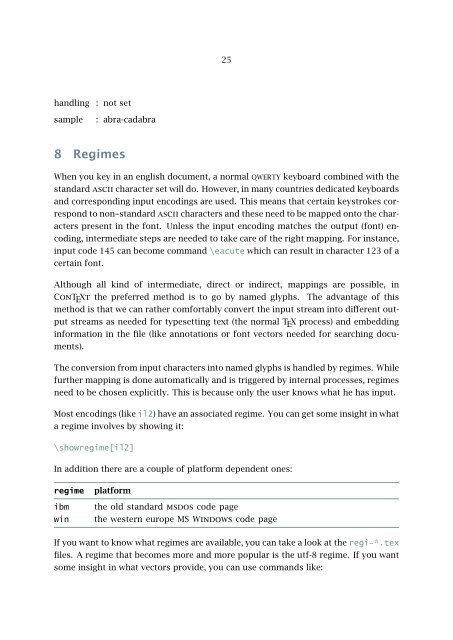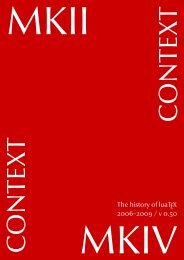font manual - Pragma ADE
font manual - Pragma ADE
font manual - Pragma ADE
Create successful ePaper yourself
Turn your PDF publications into a flip-book with our unique Google optimized e-Paper software.
25<br />
handling<br />
sample<br />
: not set<br />
: abra-cadabra<br />
8 Regimes<br />
When you key in an english document, a normal QWERTY keyboard combined with the<br />
standard ascii character set will do. However, in many countries dedicated keyboards<br />
and corresponding input encodings are used. This means that certain keystrokes correspond<br />
to non--standard ascii characters and these need to be mapped onto the characters<br />
present in the <strong>font</strong>. Unless the input encoding matches the output (<strong>font</strong>) encoding,<br />
intermediate steps are needed to take care of the right mapping. For instance,<br />
input code 145 can become command \eacute which can result in character 123 of a<br />
certain <strong>font</strong>.<br />
Although all kind of intermediate, direct or indirect, mappings are possible, in<br />
ConT E Xt the preferred method is to go by named glyphs. The advantage of this<br />
method is that we can rather comfortably convert the input stream into different output<br />
streams as needed for typesetting text (the normal T E X process) and embedding<br />
information in the file (like annotations or <strong>font</strong> vectors needed for searching documents).<br />
The conversion from input characters into named glyphs is handled by regimes. While<br />
further mapping is done automatically and is triggered by internal processes, regimes<br />
need to be chosen explicitly. This is because only the user knows what he has input.<br />
Most encodings (like il2) have an associated regime. You can get some insight in what<br />
a regime involves by showing it:<br />
\showregime[il2]<br />
In addition there are a couple of platform dependent ones:<br />
regime<br />
ibm<br />
win<br />
platform<br />
the old standard msdos code page<br />
the western europe MS Windows code page<br />
If you want to know what regimes are available, you can take a look at the regi-*.tex<br />
files. A regime that becomes more and more popular is the utf-8 regime. If you want<br />
some insight in what vectors provide, you can use commands like:
















